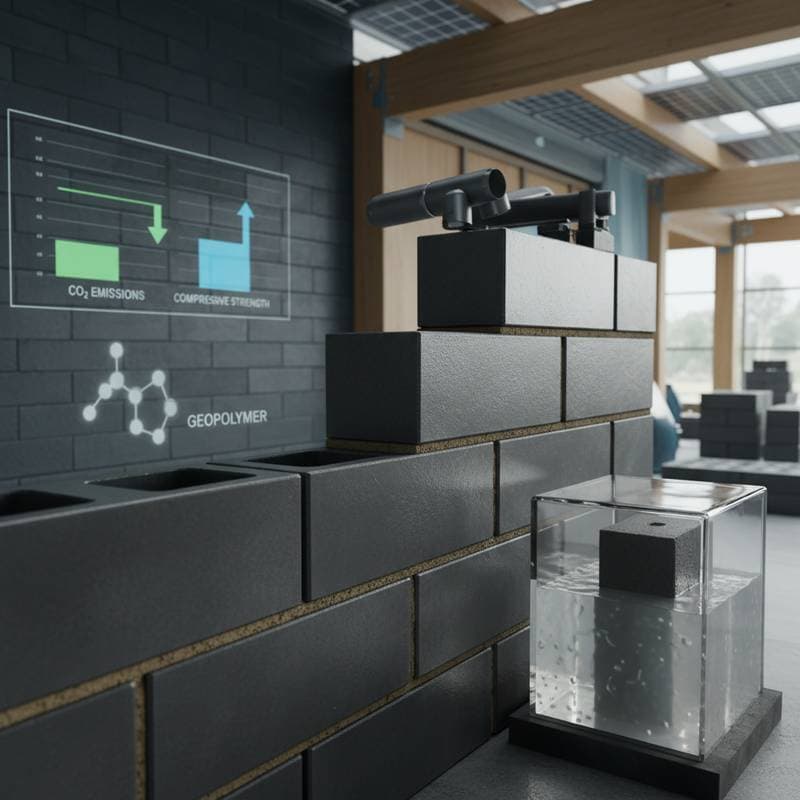Geopolymer Bricks: Cement-Free Future of Masonry
Geopolymer bricks consist of masonry units formed from industrial by-products such as fly ash, slag, or metakaolin, bypassing traditional Portland cement. An alkaline activator binds these materials into a resilient, stone-like structure. The outcome yields bricks that resemble fired clay or concrete blocks in appearance and function, yet they generate substantially lower environmental impact.
Builders increasingly favor these bricks to lower emissions without compromising on durability or lifespan. Homeowners benefit from the opportunity to construct or update structures with reduced ecological consequences while preserving high performance standards.
Costs
The material expense for geopolymer bricks generally ranges from 2 to 4 dollars per square foot for the units themselves. Installation costs span 7 to 12 dollars per square foot, influenced by factors like labor rates, site accessibility, and finishing options.
Key elements affecting pricing include:
- Source material: Fly ash and slag options prove more economical than metakaolin formulations.
- Curing process: Units cured at ambient temperatures cost less than those requiring heated, controlled environments.
- Project scale: Bulk orders or comprehensive wall assemblies lower per-unit expenses.
- Finish variations: Textured, smooth, or pigmented surfaces elevate production costs.
Although these prices exceed those of conventional concrete blocks initially, enduring benefits in reduced maintenance and ecological gains attract numerous property owners.
Specifications to Verify
Prior to purchase, evaluate these essential attributes:
- Compressive strength: Minimum 5,000 psi suits structural applications; opt for higher ratings in load-bearing or retaining walls.
- Density: Expect 120 to 140 pounds per cubic foot as standard.
- Water absorption: Select rates under 10 percent to enhance resistance to freeze-thaw cycles.
- Thermal conductivity: Assess values to align with desired insulation performance.
- Freeze-thaw rating: Seek certified durability in regions with harsh winters.
- Dimensional accuracy: Confirm sizes support modular design integration.
Request laboratory test results or industry certifications from suppliers to guarantee uniform quality.
Installation Guidelines
Geopolymer bricks assemble similarly to conventional masonry, though attention to curing and jointing proves crucial.
- Establish layout lines to outline courses and openings for precise alignment.
- Prepare mortar mixes compatible with geopolymers, as recommended by the manufacturer.
- Position bricks beginning at corners and progressing inward, maintaining uniform joint thickness.
- Monitor level and plumb alignment, adjusting minor deviations promptly.
- Tool joints to compress and finish mortar, promoting weatherproofing.
- Adhere to manufacturer protocols for curing, including moisture retention or temperature management.
- Remove excess mortar with a damp cloth before it sets fully.
Certain applications employ thin-set joints or dry-stacking techniques with proprietary adhesives. Review all mixing and curing directives meticulously for optimal results.
DIY Projects Versus Professional Installation
Small-scale decorative elements like low walls, planters, or pathways suit do-it-yourself efforts. The process mirrors traditional bricklaying, adjusted for the mortar's unique properties.
DIY approaches work best when:
- Wall height remains below 3 feet.
- Design features straightforward layouts with adequate support.
- Instructions for curing receive strict adherence.
Engage professionals for:
- Structural or load-bearing constructions.
- Complex elements involving openings, arches, or intricate corners.
- Uncertain site conditions related to drainage or foundation preparation.
- Projects subject to building codes or official inspections.
Experienced masons accustomed to concrete work transition smoothly with targeted training and supplier support.
Performance Across Regions and Climates
Geopolymer bricks adapt effectively to diverse environments, with specific considerations for local conditions.
- In cold areas: Prioritize low-absorption variants certified for multiple freeze-thaw exposures.
- In arid, hot regions: Ambient-cured bricks endure elevated temperatures and avoid thermal cracking.
- Near coastlines: Inherent resistance to salt corrosion suits marine proximity.
- In high-precipitation zones: Incorporate robust drainage and moisture barriers to prevent saturation.
- In areas prone to soil shifts: Employ flexible joints and reinforced footings to minimize fractures.
Consult local authorities early, as codes often align with traditional masonry norms; propose geopolymers as viable substitutes.
Essential Tips for Optimal Results
- Account for 5 to 10 percent additional units to cover cuts, breaks, and waste.
- Schedule installation during mild weather, steering clear of heavy rain or intense sunlight that accelerates joint drying.
- Shield newly laid walls with covers for a minimum of 24 hours to regulate moisture evaporation.
- Maintain clean tools and water supplies, as alkaline components react adversely to impurities.
- Comply precisely with specified curing temperatures, particularly for heat-treated products.
Precise craftsmanship and diligent curing elevate the structure's strength and aesthetic appeal significantly.
Preserving Geopolymer Brickwork
Installed geopolymer masonry demands minimal ongoing attention, yet routine practices sustain its integrity and appearance.
- Maintain clearance between wall bases and surrounding soil or mulch to deter moisture wicking.
- Clean surfaces annually or biannually with gentle rinsing to remove accumulated dust and debris.
- Inspect and renew sealant in joints adjacent to windows or doors as needed.
- Manage nearby plant growth to avoid root intrusion or excess humidity.
- Address stains using pH-neutral cleaners applied with a soft-bristled brush.
Steps to Incorporate Geopolymer Bricks
Homeowners eyeing masonry additions or renovations find geopolymer bricks a viable, eco-forward choice. These units slash carbon outputs, endure demanding environments, and simplify long-term care. Locate certified products through regional suppliers or sustainable building outlets to initiate your project.
From accent walls and patios to comprehensive builds, geopolymer bricks merge timeless resilience with contemporary environmental responsibility. Thoughtful planning and execution ensure a durable home that honors ecological priorities.
